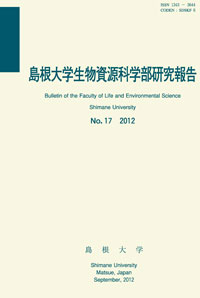島根大学生物資源科学部
ISSN:2435-0885(online)
ISSN:1343-3644(in print)
A publication of this bulletin in print format has not been made since no 24.
ISSN:1343-3644(in print)
A publication of this bulletin in print format has not been made since no 24.

number of downloads : ?
Use this link to cite this item : https://ir.lib.shimane-u.ac.jp/6929
Bulletin of the Faculty of Life and Environmental Science Shimane University 14
2009-09-30 発行
Role of tryptamine accumulation and DNA fragmentation in light-induced resistance of Sekiguchi lesion mutant of rice infected with Bipolaris oryzae
File
Description
Rice cultivar Sekiguchi-asahi was identified as a lesion mimic mutant derived from cv. Asahi. Sekiguchi-asahi showed light-enhanced resistance to Bipolaris oryzae infection inducing the formation of Sekiguchi lesions and tryptamine accumulation. No sporulation was observed on the Sekiguchi lesions. Furthermore, significant DNA fragmentation was observed in leaves with Sekiguchi lesions after inoculation with B. oryzae under light, as compared with brown spot lesions in the dark. However, pretreatment with 3-(3,4-dichlorophenyl)-1,1-dimethylurea (DCMU) suppressed the formation of Sekiguchi lesions, tryptamine accumulation, and DNA fragmentation in Sekiguchi-asahi even under light. Light-induced resistance of rice against B. oryzae is supported by tryptamine with antifungal activity, and increased DNA fragmentation might contribute to enhance the accumulation of tryptamine involved in inhibition of pathogen development such as sporulation.
About This Article
Other Article
